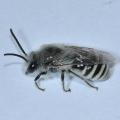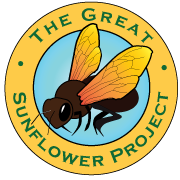

Images by Hartmut Wisch
Genus summary: Colletes (koe-LEE-teez ) is a widespread and common genus with approximately 90 species in North America and thirty one species from California. They range as far north as Alaska.
Description: Colletes are moderately hairy, slender bees. They are small to moderately large sized bees ranging from 0.3 to 0.6 inches (7 to 16 mm) long. Colletes have very hairy heads and thorax. They have pale bands of hair on their abdomen. Viewed from the front, their heads seems to taper toward the mouth and the eyes are slanted toward each other, making their heads appear heart shaped. They carry pollen in scopae on their hind legs from the upper to the lower part. They have three submarginal cells and are the only genus with an S-shaped second recurrent vein on the fore wing which you can see with a hand lens or microscope.
Similar insects: Colletes resemble some Andrena and Halictus, but the head of Colletes is more tapered, creating a heart-shaped appearance. Colletids also have a curvy vein in their fore wing that helps distinguish these bees.
Food resources: Many Colletes are floral specialists and may only visit a small number of plant species. The specialist bees are generally found on Asteraceae, Papilionaceae, Hydrophyllaceae, Braginaceae, Malvaceae, Zygophyllaceae and Salicaceae in California.
Nests: Most Colletes make solitary nests in the ground, and a few species nest in large aggregations. Often called “polyester bees,” Colletes have a unique method of lining their brood cells with a completely waterproof cellophane-like material secreted from their Dufour’s gland. The cellophane-like material does not permeate the surrounding ground; it is instead easily separable from the soil. A Colletes female completely encloses her brood cells in this waterproof membrane, thus protecting her brood from fungal attack. Colletes also secrete "linalool," a fungicide and bactericide used to protect brood cells, from a gland near their mandibles. Colletes leave provisions for their young in liquid form (like in Hylaeus species) and attach the egg to an upper wall of the brood cell rather than placing them on the provisions.
One species of fly, Miltogramma punctatum, is a specialist parasite on some Colletes species. It follows a female Colletes back to her nest and waits near the nest entrance for the bee to leave. The fly then enters the nest, deposits its egg in a Colletes cell. The egg soon hatches, and the fly larva eats the pollen and nectar in the cell causing the newly hatched Colletes larva to starve.
Flight season: This genus has a mix of spring and fall bees. There is even one species group that produced two broods a year, one in spring and one in fall.
Distribution
|
Discover Life -- click on map for details, credits and terms of use. |
